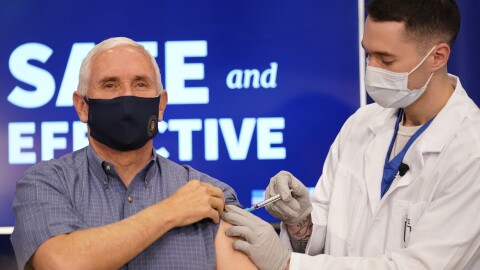Operation Warp Speed, the government effort to fast-track coronavirus vaccines, has lived up to its name: A new vaccine for a new disease is here in record time, and more are in the works.
The Pfizer vaccine was the first out of the gate. Dr. Robert Salata, chief of medicine at University Hospitals, led the Pfizer vaccine trial in Cleveland.
“It was one of the most highly scrutinized clinical trials I’ve been involved with, and I’ve been doing this for 30 years,” Salta said.
Despite the rush for approval, Salata believes the excitement surrounding the rollout of the new vaccines is well earned.
“People worry that Operation Warp Speed might be cutting corners and things like that, and that’s far from the case,” he said.
Salata says the safety trials in Cleveland will continue for two years to gauge long-term immunity and track any possible long-term side effects in participants.
How Do The New Vaccines Work?
The Pfizer vaccine, and one from Moderna that will arrive soon, are new technologies that use mRNA, or messenger RNA, a common and naturally-occurring chemical.
“We all have messenger RNA in our bodies, in all of our cells,” Salata said.
Dr. David Canaday is one of the researchers running trials of the Pfizer vaccine at the Cleveland VA hospital. He says the vaccine’s mRNA is encapsulated inside a fatty droplet, a lipid nanoparticle, which melds with our cell membranes, also made of lipids, and delivers the RNA into the cell.
“It goes into the muscle of your arm and gets picked up in a very small number of cells. It doesn’t go all over the place in your body, and it causes the body to make a small amount of protein,” Canaday said.
The vaccine tricks our cells into making the spike proteins that dot the surface of the virus like a crown (corona in Latin). The spike is the key used by the virus to enter into our cells, and all coronavirus vaccines target that protein.
Canaday says the mRNA from the vaccine is transient.
“It doesn’t stick around in your body," he said. "It does its brief little time where it makes this spike protein and then it dissolves away."
Cells that have taken up the viral RNA churn out spike proteins, which are recognized by our immune system as something to fight. Other immune cells produce antibodies for protection against future viral infection.
Both mRNA vaccines require booster shots three or four weeks after the first dose.
Ohio is set to receive around 600,000 doses of the Pfizer and Moderna vaccines, which are going first to frontline health workers and people in nursing homes. Distribution of those vaccines began last week.
It will be months before any vaccine becomes available to the general public, and by then, it’s likely not to be the mRNA type.
What Else Is In The Pipeline?
Operation Warp Speed funded two other types of vaccines. One, made by AstraZeneca, also had clinical trials in Cleveland.
That vaccine uses a very different mechanism: A cold virus from a chimpanzee delivers the RNA for the spike protein into our cells.
Salata explains that this "viral vector" cannot make you sick.
“It’s attenuated to the point where it doesn’t replicate in human cells, but it’s a large virus and you can put within it the genetic material for the spike protein,” he said.
Early results show that it works pretty well, an average of 70% effectiveness – compared to at least 94% effectiveness for the Pfizer and Moderna candidates.
“The AstraZeneca looks… effective," said Dr. Grace McComsey, head of clinical research at University Hospitals. "It induces a very strong T-cell reaction, which is the more lasting immunity.”
She’s cautiously optimistic about the AstraZeneca vaccine.
“I feel like people are a little more worried about it, that we need to see more data, longer term data,” she acknowledged.
A similar, single-dose vaccine is being developed by Johnson & Johnson.
The two other federally funded vaccines are from Novavax and Sanofi. They use yet another mechanism, introducing fragments of the spike protein itself, along with an immune booster.
You Don't Really Get To Choose
Approval of all these other vaccines is still months away. But when your turn comes to get vaccinated, you’re not really given a choice of what kind to take.
McComsey says that is O.K.
“I don’t care which manufacturer, as long as I know you’re giving me something that was FDA approved, proven to be safe," she said. "That’s what matters in the end.”





